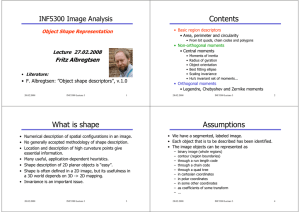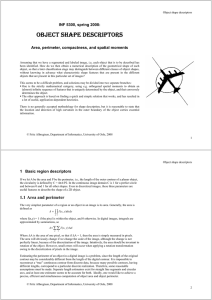Solutions for Homework #8 11-2. a)
advertisement
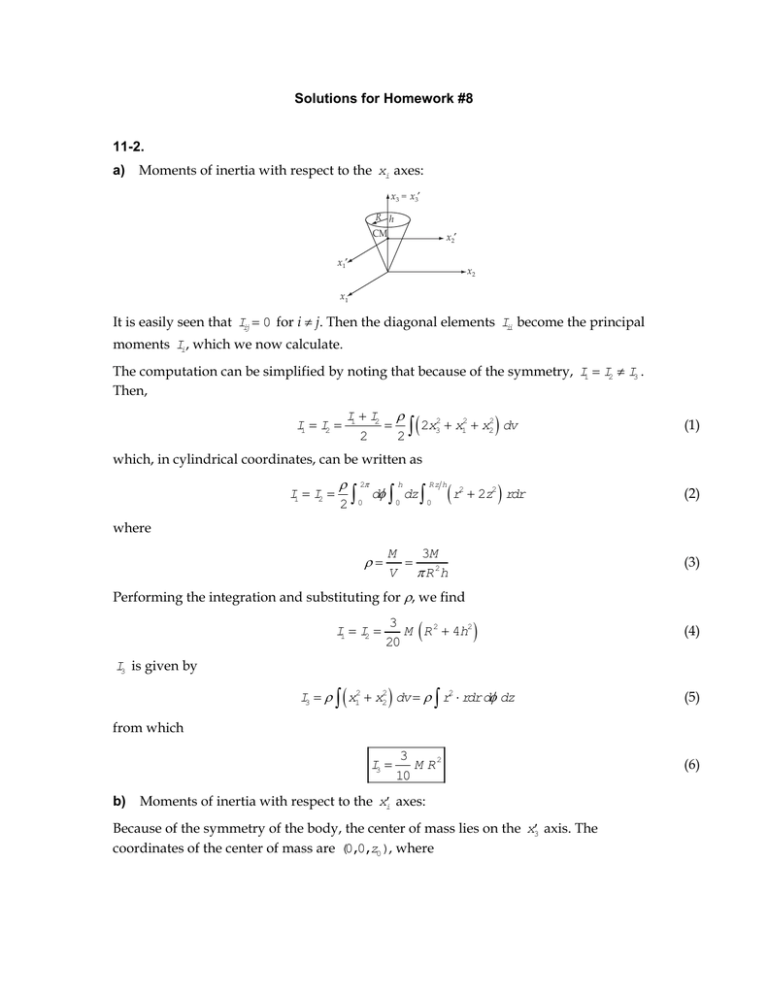
Solutions for Homework #8 11-2. a) Moments of inertia with respect to the xi axes: x3 = x3′ R h CM x2′ x1′ x2 x1 It is easily seen that Iij = 0 for i ≠ j. Then the diagonal elements Iii become the principal moments Ii, which we now calculate. The computation can be simplified by noting that because of the symmetry, I1 = I2 ≠ I3 . Then, I1 = I2 = I1 + I2 ρ = ∫ 2x32 + x12 + x22 dv 2 2 ( ) (1) which, in cylindrical coordinates, can be written as I1 = I2 = ρ 2∫ 2π 0 dφ ∫ dz ∫ h Rz h 0 0 ( r + 2z ) rdr 2 2 (2) where ρ= M 3M = V π R 2h (3) Performing the integration and substituting for ρ, we find I1 = I2 = ( 3 M R 2 + 4h2 20 ) (4) I3 is given by ( ) I3 = ρ ∫ x12 + x22 dv = ρ ∫ r2 ⋅ rdrdφ dz (5) from which I3 = b) 3 M R2 10 Moments of inertia with respect to the x′i axes: Because of the symmetry of the body, the center of mass lies on the x′3 axis. The coordinates of the center of mass are (0,0,z0 ), where (6) z0 = ∫ x′ dv = 3 h ∫ dv 4 3 (7) Then, using Eq. (11.49), ⎤ Ii′j = Iij − M ⎡⎣ a2δ ij − aa i j⎦ (8) In the present case, a1 = a2 = 0 and a3 = ( 3 4) h , so that I1′ = I1 − 9 3 1 ⎞ ⎛ M h2 = M ⎜ R 2 + h2 ⎟ 16 20 ⎝ 4 ⎠ I2′ = I2 − 9 3 1 ⎞ ⎛ M h2 = M ⎜ R 2 + h2 ⎟ ⎝ 16 20 4 ⎠ I3′ = I3 − 3 M R2 10 11-7. x θ R r d φ The force between the force center and the disk is, from the figure F = − kr (1) Only the component along x does any work, so that the effective force is Fx = − kr sin φ = − kx . This corresponds to a potential U = kx2 2 . The kinetic energy of the disk is T= 1 1 3 M x& 2 + Iθ& 2 = M x& 2 2 2 4 (2) where we use the result I= M R 2 2 for a disk and dx = R dθ. Lagrange’s equations give us 3 && + kx = 0 Mx 2 This is simple harmonic motion about x = 0 with an angular frequency of oscillations ω= 2k 3m (3) 11-11. a) No sliding: 2 2 P P From energy conservation, we have mg l l 1 1 = m g + m vC2 .M . + Iω 2 2 2 2 2 (1) where vC M is the velocity of the center of mass when one face strikes the plane; vC .M . is related to ω by vC M = l ω 2 (2) I is the moment of inertia of the cube with respect to the axis which is perpendicular to one face and passes the center: I= 1 2 ml 6 (3) Then, (1) becomes m gl 2 ( ) 2−1 = 1 m 2 2 ⎡ lω ⎤ 1 ⎡ m l ⎤ 2 1 2 2 + ⎢⎣ 2 ⎥⎦ 2 ⎢ 6 ⎥ ω = 3 m l ω ⎣ ⎦ 2 (4) from which, we have ω2 = b) 3g 2l ( ) 2−1 (5) Sliding without friction: In this case there is no external force along the horizontal direction; therefore, the cube slides so that the center of mass falls directly downward along a vertical line. θ P P While the cube is falling, the distance between the center of mass and the plane is given by y= l cosθ 2 Therefore, the velocity of center of mass when one face strikes the plane is (6) =− y& l sin θ θ& 2 0= π 4 1 1 = − lθ& = − lω 2 2 (7) θ =π 4 From conservation of energy, we have 2 mg l l 1 ⎛ 1 ⎞ 1⎛ 1 ⎞ = m g + m ⎜ − lω ⎟ + ⎜ m l 2 ⎟ ω 2 ⎠ 2 2 ⎝ 2 ⎠ 2⎝ 6 2 (8) from which we have ω2 = 12 g 5 l ( ) 2−1 (9) Bonus 11-5. z M J z–a a Q a) The solid ball receives an impulse J; that is, a force F(t) is applied during a short interval of time τ so that J= ∫ F ( t′ ) dt′ (1) dp =F dt (2) dL = r× F dt (3) Δp = ∫ F ( t′ ) dt′ = J (4) ΔL = ∫ r× F ( t′ ) dt′ = r× J (5) The equations of motion are which, for this case, yield Since p(t = 0) = 0 and L(t = 0) = 0, after the application of the impulse, we have p = M V C M = J; L = I0 ω = r× J= ( z − a) J so that ω ω (6) V CM = J M (7) and ω= J ω ( z − a) ω I0 (8) where I0 = ( 2 5) M a2 . The velocity of any point a on the ball is given by Eq. (11.1): vα = V C M + ω × rα (9) For the point of contact Q, this becomes vQ = V C M − ω a = J J J ⎡ 5( z − a) ⎤ 1− M ⎢⎣ 2a ⎥⎦ (10) Then, for rolling without slipping, vQ = 0 , and we have 2a = 5( z − a) (11) so that z= 7 a 5 (12)
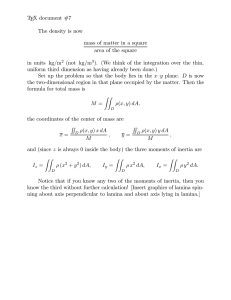

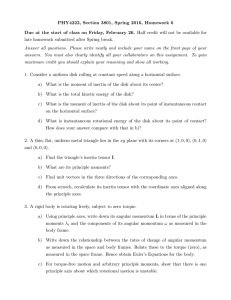
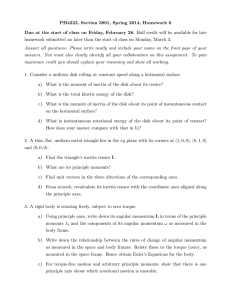



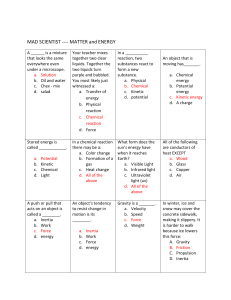
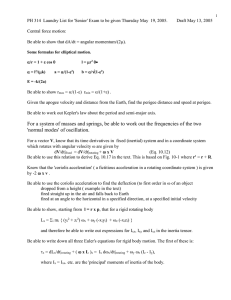
![[ ]](http://s2.studylib.net/store/data/013590594_1-e2fe91ced984fc8c9bf9d956b855440e-300x300.png)
